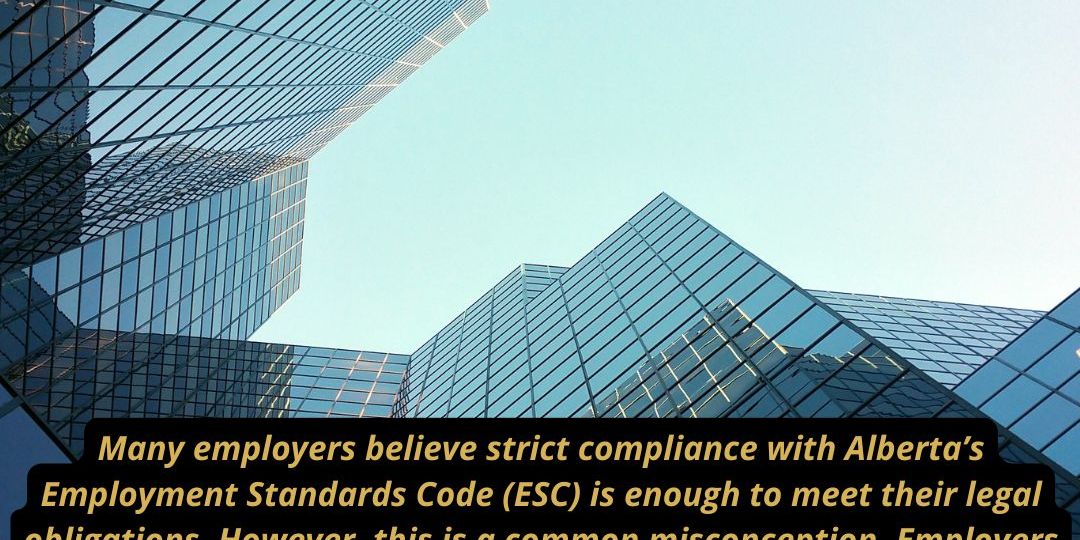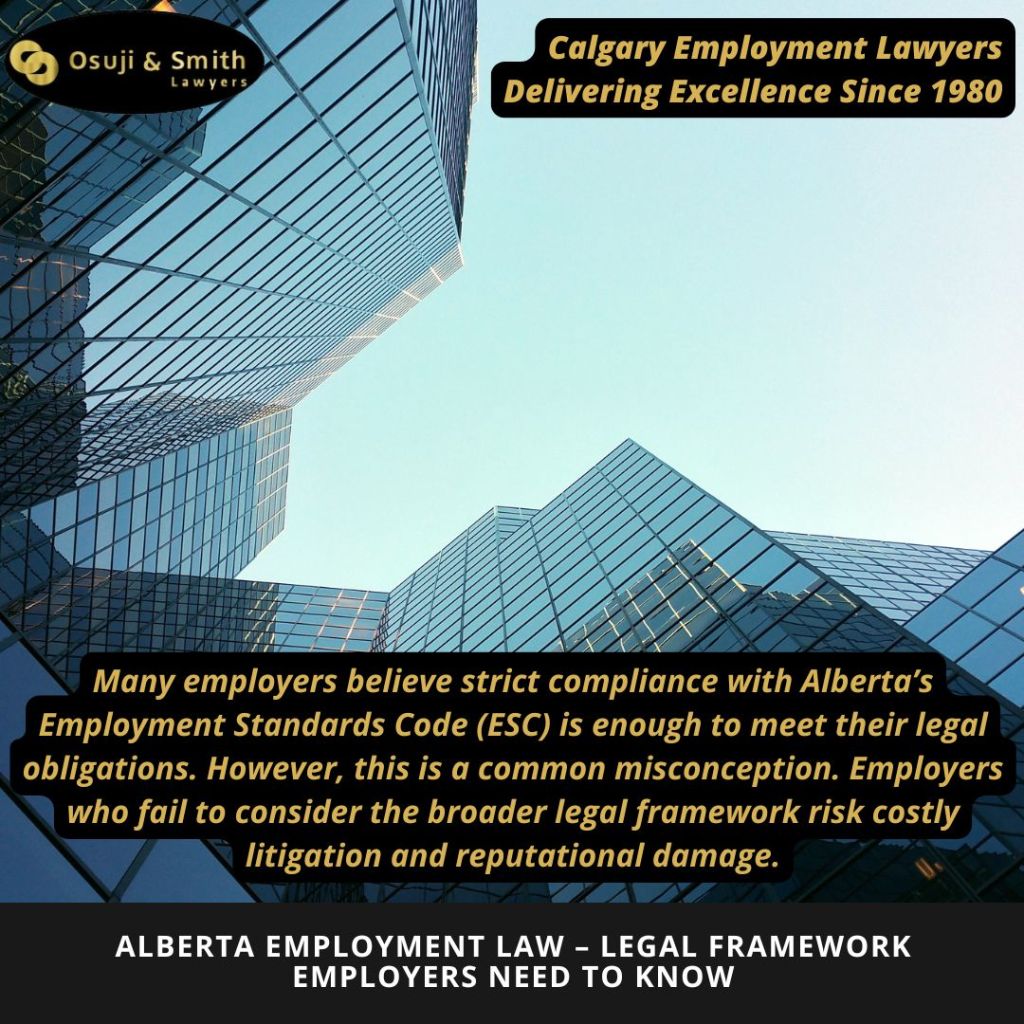
Post 1: Alberta Employment Law – Legal Framework Employers Need to Know
Many employers believe strict compliance with Alberta’s Employment Standards Code (ESC)is enough to meet their legal obligations. However, this is a common misconception. While the ESC provides statutory minimums, Common Law principles often impose more outstanding obligations, particularly concerning termination notice, constructive dismissal, and severance pay. Employers who fail to consider the broader legal framework risk costly litigation and reputational damage.
How Statutes and Common Law Interact in Employment Disputes
Employment law in Alberta is shaped by statutory law (such as the ESC and the Alberta Human Rights Act) and Common Law, which consists of judicial decisions interpreting these statutes and employment relationships. Statutory law provides baseline protections, such as minimum wage, overtime rules, and statutory notice periods. However, Common Law principles developed through court decisions often provide employees with greater rights than statutory minimums.

Key Employer Obligations Under Alberta Law
Employers in Alberta must comply with multiple legal frameworks enumerated as follows:
1. The Employment Standards Code
The ESC establishes minimum employment rights, such as:
Minimum Wage: (ESC, Section 8.1)
Currently set at $15 per hour, with exceptions for students and liquor servers.
Hours of Work and Rest Periods: (ESC, Sections 16-18)
The standard workday is 8 hours per day or 44 hours per week, after which overtime applies. Employees are entitled to at least a 30-minute break after 5 consecutive work hours.
Overtime Rules: (ESC, Section 21)
Employees must be paid 1.5 times their regular wage for overtime hours unless they are exempt.
General Holidays and Holiday Pay: (ESC, Sections 25-30)
Alberta recognizes 9 statutory holidays, including New Year’s Day, Canada Day, and Christmas.
Vacation and Vacation Pay: (ESC, Sections 34-39)
Employees are entitled to two weeks of vacation after one year of service (4% of annual earnings as vacation pay and three weeks after five years of service (6% vacation pay).
Termination Notice: (ESC, Sections 56-64)
Employers must provide notice or pay in lieu, ranging from one to eight weeks, based on length of service. Employers can provide pay in lieu of noticeinstead of requiring an employee to work the notice period. If an employer fails to provide proper notice, the employee may claim wrongful dismissal under Common Law, where reasonable notice could be much longer.
Maternity, Parental, and Personal Leaves (ESC, Sections 45-53)
Employees are entitled to maternity leave (16 weeks) and parental leave (up to 62 weeks). Employers cannot terminate or penalize employees for taking legally protected leave.
Temporary Layoffs and Recall Rights (ESC, Sections 62-64)
Employers can temporarily lay off employees for up to 90 days within 120 days. After 90 days, the layoff becomes a termination, requiring termination pay. Employees must be given written notice of recall within the allowed period, or they will be deemed terminated.
2. The Alberta Human Rights Act
This legislation prohibits discrimination based on protected grounds, such as Race, Religious beliefs, Color, Gender (including pregnancy and gender identity), Physical disability, Mental disability, Age, Ancestry, Place of origin, Marital status, Source of income, Family status and Sexual orientation.
3. Occupational Health and Safety (OHS) Legislation
Under Alberta’s Occupational Health and Safety Act (OHSA), employers have a legal duty to ensure a safe and healthy work environment. Failure to meet OHS standards can result in fines and work stoppages. Construction and Engineering companies are especially at risk of violating OHS standards.
4. Workers’ Compensation Board (WCB) Obligations
Alberta’s Workers’ Compensation Act requires most employers to carry workers’ compensation coverage. Most workers must be covered for workplace injuries. Employers must contribute to the workers’ compensation fund. Injured employees must be provided with proper medical attention, and the incident must be reported to WCB promptly. Employers must support injured employees in returning to suitable work where possible.
When Common Law Overrides Statutory Minimums
- Termination and Reasonable Notice
Under the ESC, an employer may believe that providing the required statutory notice (e.g., four weeks for a five-year employee) is sufficient. However, Common Law generally requires reasonable notice, which can be much longer—sometimes up to 24 months for long-term, senior employees.
Example:
A manager with 10 years of service is terminated without cause. The employer provides the ESC-required eight weeks of pay in lieu of notice. However, under Common Law, the manager may be entitled to 10–12 months of reasonable notice. The employee could sue for wrongful dismissal if the employer fails to pay this.
2. Constructive Dismissal
Common Law also protects employees from unilateral changes to fundamental terms of employment. Employers who significantly reduce an employee’s pay, change job duties, or create a toxic work environment may trigger a constructive dismissal claim, entitling the employee to severance as if they were terminated.
Example:
An employer reduces an employee’s salary by 20% without consent. Under Common Law, the employee may resign and sue for wrongful dismissal, arguing they were effectively forced out.
Recent Court Decisions Impacting Employer Responsibilities
1. Supreme Court of Canada Rulings on Termination Clauses
The Supreme Court has consistently ruled against employers attempting to contract out of Common Law reasonable notice unless the language is clear and unambiguous. If a termination clause in an employment contract does not explicitly exclude Common Law rights, courts will assume employees are entitled to Common Law notice.
In Shell Global Solutions Canada Inc. v. Terri Rice, 2022 CanLII 58768 (SCC) the Alberta Court of Appeal ruled in favor of the employee, Ms. Rice, due to ambiguities in her employment contract—particularly around terms like “Assignment Length” and provisions related to termination and severance pay. The Court found that these unclear clauses indicated a fixed-term contract and, in the absence of clear early termination provisions, awarded Ms. Rice damages equivalent to the salary she would have earned for the remainder of the term. An appeal of this decision to the Supreme Court was dismissed. This decision underscores the legal principle that ambiguities in employment agreements are interpreted in favor of employees, emphasizing the critical importance of clear, precise language in contracts to avoid costly disputes and ensure mutual understanding of rights and obligations.
2. Duty of Good Faith in Employment Relationships
The Supreme Court has reinforced that employers must act in good faith when terminating employees. This means:
- Providing accurate reasons for termination.
- Avoiding misleading or deceptive conduct.
- Ensuring terminations are not unnecessarily humiliating.
In the case of Matthews v Ocean Nutrition Canada, 2020 SCC 26, the Supreme Court of Canada emphasized the employer’s duty of good faith in the context of employment termination. The court ruled that employers must act honestly and fairly when terminating an employee, particularly regarding the manner and timing of the dismissal. This case established that a breach of this duty can result in damages beyond mere notice periods, as it reflects on the employer’s conduct during the termination process. The decision underscored that good faith is a fundamental aspect of the employment relationship, requiring employers to consider the impact of their actions on employees.
Failure to act in good faith can lead to aggravated or punitive damages, increasing employer liability significantly.
Key Takeaways for Employers
- The ESC provides minimum standards, not maximum obligations. Employers must also consider Common Law principles.
- OHS and WCB laws impose additional workplace safety and injury management responsibilities.
- Termination notice under Common Law is often much longer than ESC requirements. Employers should assess reasonable notice before terminating employees.
- Employment contracts must be drafted carefully to ensure termination clauses are enforceable.
- Unilateral changes to employment terms can lead to constructive dismissal claims. Employers should obtain employee consent before making significant changes.
- Courts expect employers to act in good faith during terminations to avoid additional liability.
Watch out for my next post entitled: Managing Terminations, Layoffs and Severance – Understanding Statutory and Common Law Obligations

